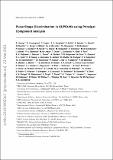Pulse shape discrimination in CUPID-Mo using principal component analysis
Author(s)
Winslow, Lindley
DownloadAccepted version (562.9Kb)
Open Access Policy
Open Access Policy
Creative Commons Attribution-Noncommercial-Share Alike
Terms of use
Metadata
Show full item recordAbstract
<jats:title>Abstract</jats:title>
<jats:p>CUPID-Mo is a cryogenic detector array designed to search for neutrinoless double-beta decay (0νββ) of <jats:sup>100</jats:sup>Mo. It uses 20 scintillating <jats:sup>100</jats:sup>Mo-enriched Li<jats:sub>2</jats:sub>MoO<jats:sub>4</jats:sub> bolometers instrumented with Ge light detectors to perform active suppression of α backgrounds, drastically reducing the expected background in the 0νββ signal region. As a result, pileup events and small detector instabilities that mimic normal signals become non-negligible potential backgrounds. These types of events can in principle be eliminated based on their signal shapes, which are different from those of regular bolometric pulses. We show that a purely data-driven principal component analysis based approach is able to filter out these anomalous events, without the aid of detector response simulations.</jats:p>
Date issued
2021Department
Massachusetts Institute of Technology. Department of PhysicsJournal
Journal of Instrumentation
Publisher
IOP Publishing
Citation
Winslow, Lindley. 2021. "Pulse shape discrimination in CUPID-Mo using principal component analysis." Journal of Instrumentation, 16 (03).
Version: Author's final manuscript